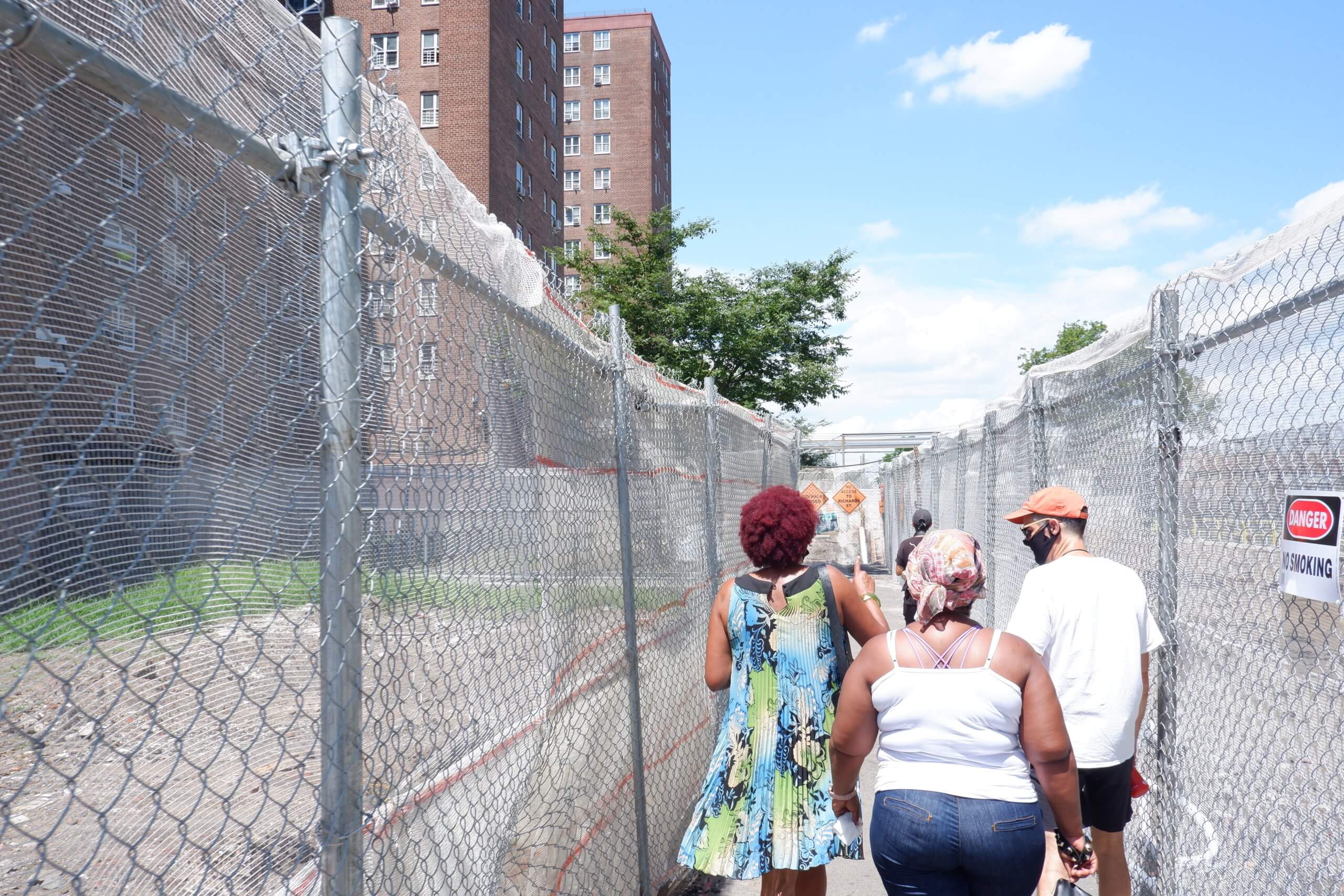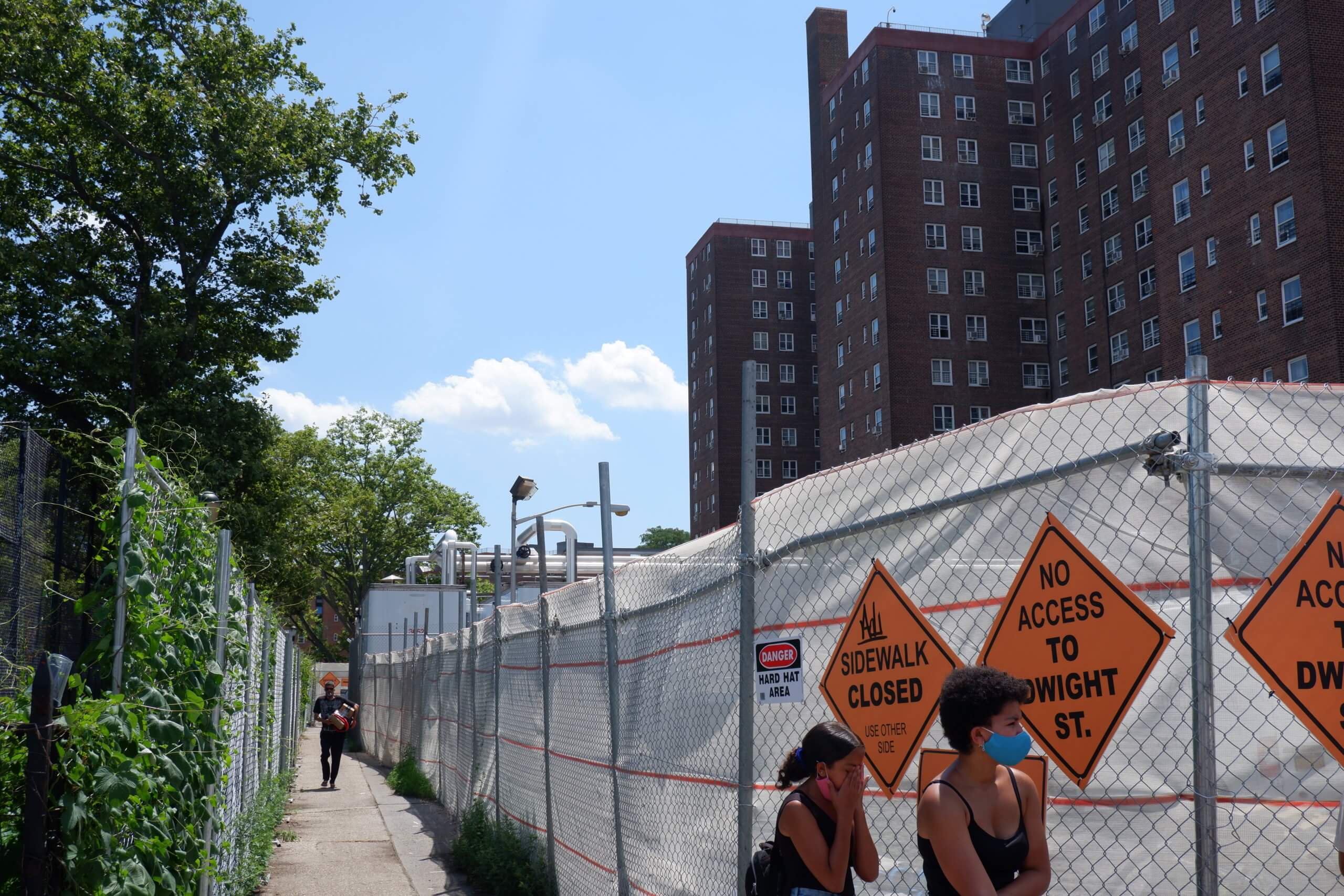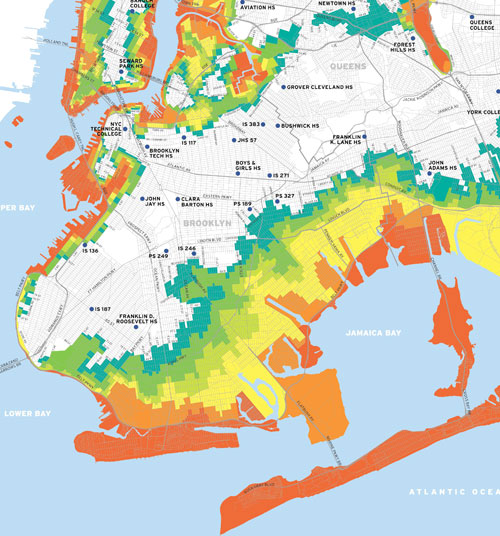A group of Red Hook public housing residents claim that city contractors have overwhelmed tenants with “unbearable” construction as they sit home during the hot summer and the ongoing coronavirus outbreak.
“The overwhelming presence of fencing and blockage of pathways in the midst of COVID-19 is unbearable,” said Nahisha McCoy, a 23-year resident of the Red Hook Houses NYCHA complex. “We have lost ballfields, the playgrounds, the basketball courts, and the benches all at once during the pandemic.”
The tenants took their complaints to the streets for a July 28 rally, demanding community oversight over the $550 million federally-funded resiliency upgrades to the complex, which began in 2017, and aim to storm-proof the vast 40-acre complex.
The project comes in response to the significant amount of damage brought by 2012’s Superstorm Sandy, which ravaged the development that lies in one of the city’s most perilous flood zones.
The Red Hook Houses is one of 35 NYCHA developments along the waterfront that city officials plan to make over as part of the $3 billion federal Sandy recovery program — although the funds were slow to arrive, coming in only at the end of 2015.
A 2019 review by the news outlet The City showed most projects missed their start dates, and that city investigators raised red flags about spikes in costs to stormproof the 200 damaged buildings.
In Red Hook, what started with the renovation of a senior center, retail space, roof repairs, and some residential units in late 2019, has now overtaken the entire development.
The larger work includes new utility pods to prevent the complex from losing power like it did when Sandy battered the coastal neighborhood, raising courtyards and playgrounds above flood levels, and other various building repairs.
In the meantime, residents complain workers have razed and closed off almost all common spaces and playgrounds, removed most benches, and felled more than 450 trees to make way for the repairs. Making matters worse, crews have constructed a large-scale, semi-transparent white mesh fence, creating narrow pathways between the different housing developments — and potentially putting residents in harm’s way.

One Red Hook NYCHA tenant said that during two recent fires in the western half of the housing complex, firefighters had trouble getting their ladders past the construction fence, and in one case had to break down the fence to quell a building blaze.
“The Fire Department didn’t know where to go. This is a death trap,” said the woman, who only identified herself as Lisa.
Another resident bemoaned the loss of communal space due to the construction — a problem that has only been compounded by the need for outdoor space amid the pandemic.
“The community was dug up all at once, we have lost many of our public spaces,” added Vanessa McKnight. “A plan needs to be developed to increase access to playgrounds, benches, and basketball courts.”
Regarding the chopped trees, the New York City Housing Authority said in a presentation that it “strives for 1-for-1 replacement at the end of each project as space constraints and funding permit,” but advocates demanded that the city show a stronger commitment to bringing back the greenery by presenting a clear plan.
In addition to a loss of public space and trees, residents reported a host of other issues as a result of the work, including the loss of water when construction workers damaged pipes.

McKnight also demanded that the city and feds conduct testing and remediation of the historically-polluted soil in the neighborhood, worrying that builders will dig up and spread toxins.
The city’s Parks Department is in the process of remediating the nearby Red Hook Ball Fields along Bay Street due to lead contamination by a 1930s smelting site at Lorraine and Hicks streets.
At their recent rally, which was organized by the local youth development non-profit Red Hook Initiative, the public housing tenants demanded NYCHA and its contractors keep them better abreast of the project, with weekly construction updates and a community liaison.
Local councilman Carlos Menchaca spoke in favor of the demands, saying that even if the scheme to storm-proof the complex was crucial, the way to get there needed to be improved with more input from locals.
“We are hearing directly from people who live there and are being treated with no respect and transparency,” he said. “The resiliency project here will make these houses safer if the next Sandy comes, that’s good, but the means to get there is not good. If they say ‘Stop,’ we have to listen.”
A spokeswoman for NYCHA claimed that the Authority conducted extensive outreach ahead of the project and that the current impacts of the work would make the buildings safer for future extreme weather events.
“The construction NYCHA is doing at Red Hook Houses is the culmination of years of meetings with residents, community leaders and other stakeholders,” said Rochel Leah Goldblatt in a statement. “We understand the impacts of this investment are inconvenient to residents, but we are thankful for the $550 million our elected officials secured for these critical infrastructure upgrades, including new heat and hot water systems and full backup generators, to protect the residents and these buildings for the next generation of NYCHA residents.”
Goldblatt later added that NYCHA does indeed have a liaison for the community in addition to an outreach team for the entire recovery program across all 35 sites, and that the Authority used to attend monthly tenant association meetings pre-COVID. Officials plan to replace those sessions with Zoom calls for the duration of the pandemic, along with regular progress emails to stakeholders detailing current and future work, the rep said.























